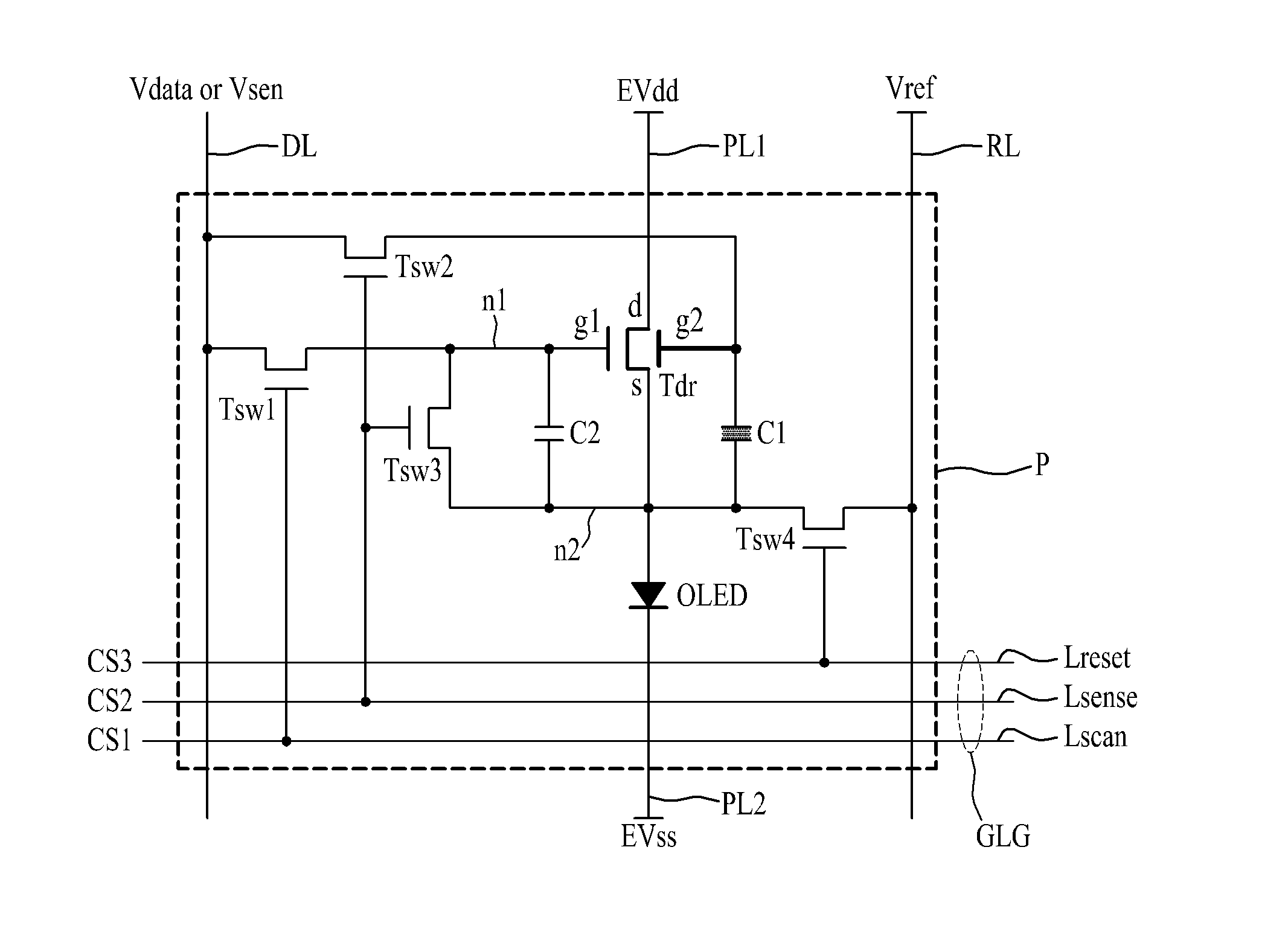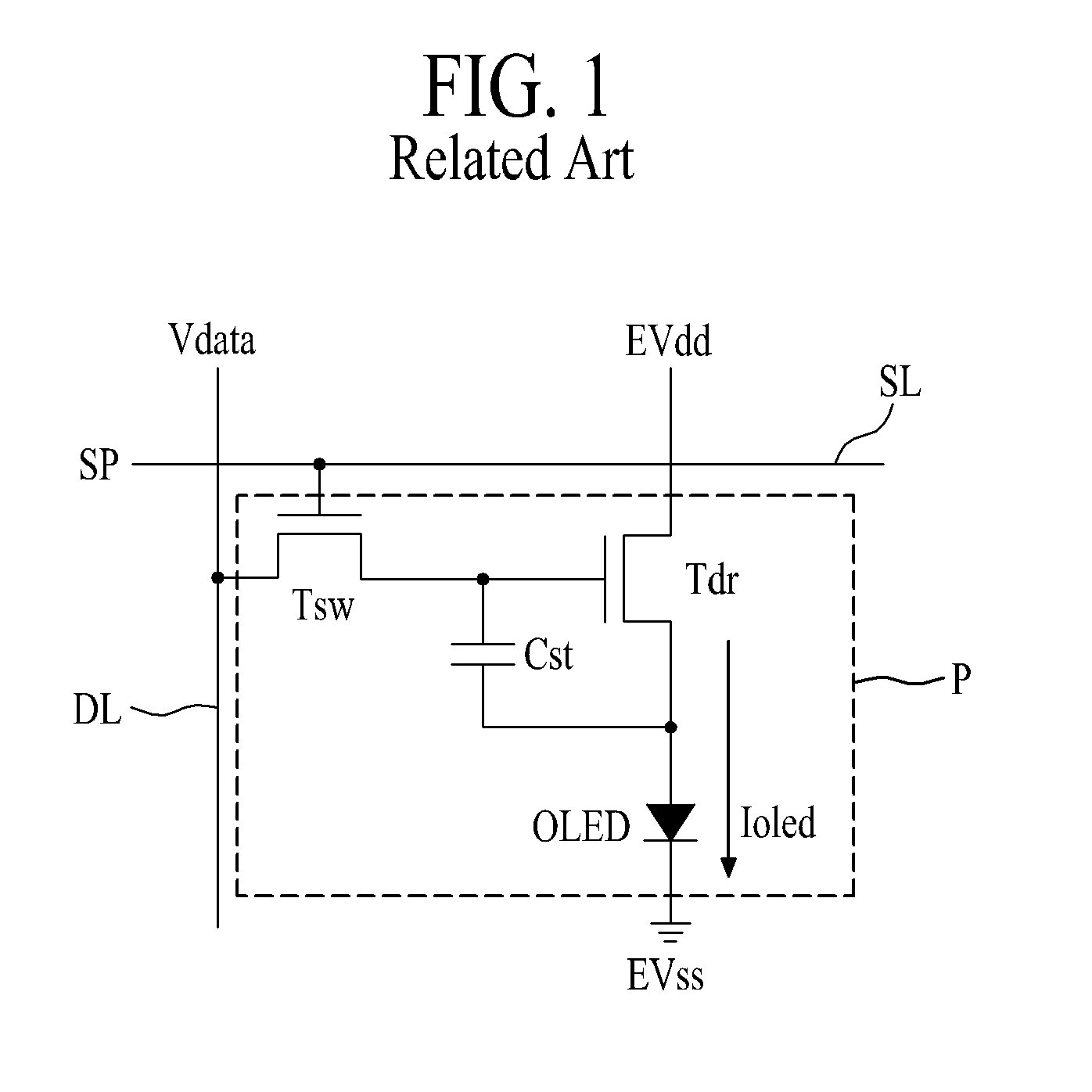Organic light emitting display device and method for driving the same
a light-emitting display and organic technology, applied in the direction of static indicating devices, instruments, etc., can solve the problems of thin film transistor reliability degradation and display panel reliability, and achieve the effect of improving picture quality, reliability and lifespan of switching transistors
- Summary
- Abstract
- Description
- Claims
- Application Information
AI Technical Summary
Benefits of technology
Problems solved by technology
Method used
Image
Examples
first embodiment
[0048]FIG. 2 is a circuit diagram illustrating a pixel structure of an organic light emitting display device according to the present invention. FIG. 3 is a cross-sectional view illustrating a structure of a driving transistor shown in FIG. 2
[0049]Referring to FIGS. 2 and 3, a pixel P is connected to a data line DL, a gate line group GLG, a reference line RL, a first driving power line PL1, and a second driving power line PL2.
[0050]The data line DL is formed along a first direction of a display panel (not shown), for example, a vertical direction. A data voltage Vdata from a data driver (not shown) is supplied to the data line DL.
[0051]The gate line group GLG is formed along a second direction of the display panel, for example, a horizontal direction to cross the data line DL. The gate line group GLG includes a scan control line Lscan, a sensing control line Lsense, and a reset control line Lreset.
[0052]The reference line RL is formed to be parallel with the data line DL. The refere...
second embodiment
[0101]The pixel P according to external compensation driving of the second embodiment may include the reset period t1 shown in FIG. 4A, the data addressing period AP shown in FIG. 5A or FIG. 5C, and the light emitting period EP shown in FIG. 5B.
[0102]During the data addressing period AP of the external compensation driving according to the first and second embodiments, the data voltage converted from the corrected data corrected based on the sensing data Sdata, that is, the data voltage that includes a compensation voltage for compensating the threshold voltage of the driving transistor Tdr is supplied to the corresponding data line.
[0103]FIG. 7 is a diagram illustrating a structure of a pixel according to the second embodiment of the present invention, wherein a sensing voltage line for supplying a sensing voltage is additionally provided in a second switching transistor.
[0104]As described above, in the pixel P according to the first embodiment of the present invention, the first e...
third embodiment
[0107]FIG. 8 is a diagram illustrating a structure of a pixel according to the present invention, wherein a connection structure of first and second gate electrodes of the driving transistor Tdr is changed. Hereinafter, only different elements will be described.
[0108]As described above, in the pixel P according to the first embodiment of the present invention, the first gate electrode g1 of the driving transistor Tdr is connected to the first and third switching transistors Tsw1 and Tsw3 and the second capacitor C2 through the first node n1, and the second gate electrode g2 of the driving transistor Tdr is connected to the second switching transistor Tsw2 and the first capacitor C1.
[0109]On the other hand, as illustrated in FIG. 8, in the structure of the pixel P according to the third embodiment of the present invention, positions of the first and second gate electrodes g1 and g2 of the driving transistor Tdr are exchanged. In other words, the first gate electrode g1 of the driving...
PUM
 Login to View More
Login to View More Abstract
Description
Claims
Application Information
 Login to View More
Login to View More - R&D
- Intellectual Property
- Life Sciences
- Materials
- Tech Scout
- Unparalleled Data Quality
- Higher Quality Content
- 60% Fewer Hallucinations
Browse by: Latest US Patents, China's latest patents, Technical Efficacy Thesaurus, Application Domain, Technology Topic, Popular Technical Reports.
© 2025 PatSnap. All rights reserved.Legal|Privacy policy|Modern Slavery Act Transparency Statement|Sitemap|About US| Contact US: help@patsnap.com



